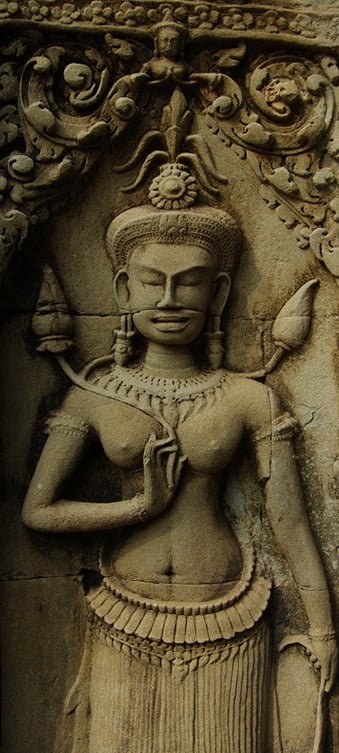Devata Goddess Temples

The Khmer civilization that grew to unify most of Southeast Asia between the 8th-14th centuries respected women as seen in their devata goddess temples.
The Khmer leaders implemented systems of government, religion, education, agriculture and architecture that still color life in Cambodia, Thailand, Laos and Vietnam today. Exactly what roles women played in establishing these systems is still largely unknown, but new research indicates that women were politically, socially, spiritually and economically empowered and that they were important contributors to shaping Khmer society.
Today, we still see their temples filled with images of sacred women –termed devata, apsara or Khmer goddesses — who embody the feminine forces of the universe. While women and goddesses appear as icons in many ancient and modern societies, the Khmers gave sanctified women dominance over their state temples more consistently and more visibly than any other group.
This page links to articles and photos specifically relating to Khmer temples featuring devata. Almost all of these are in modern Cambodia, with two important exceptions in Thailand and Laos. For a general photo index of Khmer temples in all three countries, please visit The Best Online Khmer Temple Photo Index.
Many women of Southeast Asia are still blessed with the feminine beauty, power and spiritual harmony that the ancient Khmers honored. We have only to look and continue trying to understand.
Devata.org photo sets and related devata articles appear in red.
Outside links to devata temple pages appear in green (note that devata are not necessarily included in these images).
[Devata counts] with approximate number of devata at each temple appear in brackets. Special thanks to JASA research archeologist Robert McCarthy for sharing his data to augment this list.
Khmer Devata Goddess Temples
Angkor Wat Devata Inventory [1,795]
Angkor Wat Devata – West Gopura Outside [119]
Angkor Wat Devata – West Gopura Inside [124]
- Bakong Devata (By Andy Brouwer)
- Banteay Chhmar (Banteay Meanchey)
- Banteay Chhmar (George Groslier’s 1937 article)
- Banteay Kdei (Siem Reap) [399]
- Banteay Prei (Siem Reap) [103]
- Banteay Srei (Siem Reap)
- Banteay Thom [21]
- Bayon (Siem Reap) [377]
- Bayon Goddesses of King Jayavarman VII [377]
- Beng Mealea (Siem Reap) [16]
- Beng Mealea Devata
- Chau Say Tevoda (Siem Reap) [41]
- Chao Say Tevoda – Key Devata Temple Reopens [41]
- Elephant Terrace (Angkor Thom) [1]
- Leper King Terrace (Angkor Thom)
- Phnom Bok (Siem Reap)
- Phnom Bok Devata (on AngkorGuide.net)
- Prasat Bakong (Siem Reap)
- Prasat Banteay Kdei (Siem Reap)
- Prasat Banteay Prei (Siem Reap) [20]
- Prasat Banteay Srei (Siem Reap) [16]
- Prasat Beng Mealea (Siem Reap)
- Prasat Beng Mealea Devata
- Prasat Chrung NE [24]
- Prasat Chrung NW [24]
- Prasat Chrung SE [22]
- Prasat Chrung SW [16]
- Prasat Mebon (Banteay Chhmar)
- Prasat Phnom Bok (Siem Reap)
- Prasat Phnom Bok Devata (on AngkorGuide.net)
- Prasat Pithu (Siem Reap) [29]
- Prasat Prasat Krol Ko (Siem Reap)
- Prasat Preah Khan (Siem Reap)
- Prasat Preah Ko (Siem Reap)
- Prasat Prei (Siem Reap) [20]
- Prasat Sikhoraphum (Thailand)[2]
- Prasat Ta Keo Hospital Chapel [10]
- Prasat Ta Prohm Kel (Siem Reap) [9]
- Prasat Ta Prohm (Banteay Chhmar)
- Prasat Ta Prohm (Siem Reap) [380+]
- Prasat Ta Som (Siem Reap)
- Prasat Ta Som Devata
- Prasat Trapeang Phong (Siem Reap)
- Preah Khan (Siem Reap)
- Preah Khan Devata in the Heart of the Temple
- Preah Khan Devata of Darkness
- Preah Khan Devata of Light
- Preah Khan Devata of Shadows
- Preah Pithu (Angkor Thom)
- Preah Pithu (wikipedia) [29]
- Ta Som (Siem Reap)
- Ta Som Devata
- Thommanon (Siem Reap) [24]
- Thommanon Devata at the Gate of Victory [24]
- Wat Athvea (Siem Reap) [6]
- Wat Athvea Devata [6]
- Wat Phu (Laos) [2]
